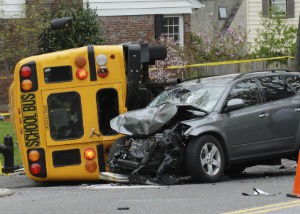 One student and one teacher are dead following a deadly school bus accident in New Jersey. While the students on board were reportedly all wearing seatbelts, the tragic incident prompted the New York Times to answer the following question: Are school bus seatbelts required?
One student and one teacher are dead following a deadly school bus accident in New Jersey. While the students on board were reportedly all wearing seatbelts, the tragic incident prompted the New York Times to answer the following question: Are school bus seatbelts required?
School Bus Accident Leaves Two Dead
On May 17, 2018, a school bus carrying 38 fifth-grade students, six chaperones, and one driver was traveling on Interstate 80 to Waterloo Village, a recreated 19th-century town, as part of a field trip from East Brook Middle School in Paramus, NJ. The school bus then crashed into a dump truck just west of Exit 25, only a few miles from its destination.
The force of the collision with the dump truck ripped the front cabin of the school bus from its chassis and caused the vehicle to roll over onto the grassy median separating the eastbound and westbound lanes. An eyewitness described a chaotic scene following the school bus accident, with some students reportedly “hanging from their seatbelts” while others climbed out of windows and a rooftop emergency exit.
One student, 10-year-old Miranda Vargas, was killed in the school bus accident, as was social studies teacher Jennifer M. Williamson. Injured parties were taken for medical treatment to area hospitals, with several reportedly in “grave condition” following surgery.
The school bus, which belonged to the Paramus Board of Education, was one of three that had been transporting students for the field trip. The other two buses returned safely to school.
Authorities are investigating claims that the school bus driver may have missed the exit and attempted to make an illegal U-turn.
School Bus Seatbelts – Required or Not?
All of the students riding the school bus were reportedly wearing seatbelts at the time of the crash. However, the circumstances surrounding this tragic school bus accident – in which students were literally “hanging from their seatbelts” – prompted a review by the New York Times to determine whether school bus seatbelts are even required.
The short answer? Sometimes, depending on the size of the bus and its location.
According to federal motor vehicle safety standards, smaller school buses – ones weighing 10,000 pounds or less – are legally required to have lap-shoulder seatbelts. However, there are no federal rules regulating seatbelts in larger school buses.
Nevertheless, certain states do still require seatbelts on all school buses, regardless of size. So far, eight states – Arkansas, California, Florida, Louisiana, Nevada, New Jersey, New York, and Texas – have passed laws making school bus seatbelts mandatory. In some cases, however, certain school buses may be exempt from having seatbelts if states or school districts do not provide funding for them.
Still, there seems to be growing interest among the states to make school bus seatbelts mandatory, with 29 states introducing bills in 2017 to address the issue.
But Do Students Have to Wear Them?
Of course, seatbelts only work if you wear them. Do students have to do so? It depends on the state.
All New Jersey students, for instance, are required to wear school bus seatbelts. In the State of New York, however, whether or not students have to belt up is a decision that is left to each school district. New York City, for example, does not require them except in the case of special education students.
Seatbelt Safety Statistics
As to whether seatbelts make school buses safer, there has been surprisingly little data collected on that particular issue, though school buses remain a relatively safe means of travel.
According to the National Highway Traffic Safety Administration (NHTSA), there were an estimated 37,150 traffic deaths in the United States last year. As a point of comparison, the NHTSA reports that an average of four to six children die in school vehicles annually.
Larger school buses are particularly safe because they are heavier than passenger vehicles, with sturdy, closely spaced seats that offer crash protection even without seatbelts. Smaller school buses, however, are closer in size and weight to passenger vehicles, making them more dangerous. For that reason, seatbelts are mandatory.
It is also worth noting that not all school bus seatbelts are created equal. There are currently two types: the older-style lap belts and the newer lap-shoulder belts. The latter are generally considered safer in a school bus accident, prompting groups such as the American Academy of Pediatrics and the National Association of State Directors of Pupil Transportation Services to advocate for their widespread installation.
Illinois School Bus Accident Lawyers
A school bus accident is a traumatic event, one that threatens that which every family holds most dear. For this reason, many families find that they could benefit from the guidance of an experienced school bus accident lawyer to help them get the financial compensation that their child deserves, like the Illinois school bus accident lawyers at GWC Injury Lawyers, Illinois’ largest Personal Injury and Workers’ Compensation law firm.
If you or a loved one has been injured, in a school bus accident or in some other way, please contact GWC today to schedule a free consultation with one of our attorneys. Call our office at (312) 464-1234 or click here to chat with one of our representatives.
<< BACK TO BLOG POSTS